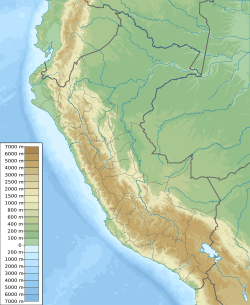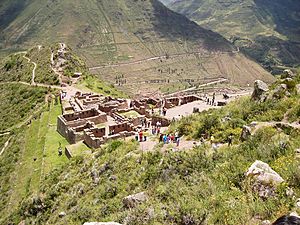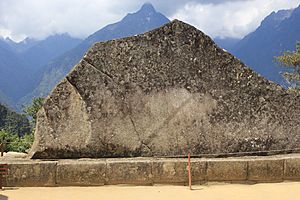Sacred Valley facts for kids
Quick facts for kids Sacred Valley |
|
|---|---|
| Urubamba Valley | |
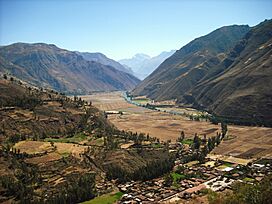
Sacred Valley of the Incas
|
|
| Geography | |
| River | Urubamba River |
|
Invalid designation
|
|
| Official name | Valle Sagrado de los Incas |
| Type | Immovable tangible |
| Criteria | Archaeological and Historical Cultural Landscape |
| Designated | 22 June 2006 |
| Legal basis | R.D.N. Nº 988/INC-2006 |
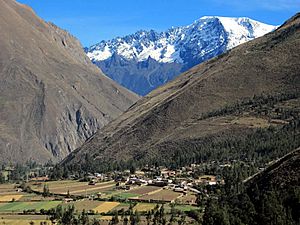
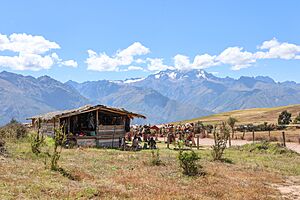
The Sacred Valley of the Incas, also known as the Urubamba Valley, is a beautiful and important valley in the Andes mountains of Peru. It's located north of Cusco, which was once the capital of the powerful Inca Empire. The local people also call it Willka Qhichwa in Quechua, which means "Sacred Valley."
This amazing valley slowly became part of the growing Inca Empire between the years 1000 and 1400. Today, it's a very popular place for visitors from all over the world. Many people come to see famous ancient sites like Machu Picchu and other fascinating ruins.
The valley stretches from Pisac to Ollantaytambo and is watered by the Urubamba River. Its rich soil has been used for farming for thousands of years. Ancient groups like the Chanapata people lived here around 800 BCE, followed by the Qotacalla and Killke civilizations, before the Incas took over around 1420. The Incas ruled this area for about 100 years until the Spanish arrived.
Contents
Discovering the Sacred Valley of the Incas
Where is the Sacred Valley?
The Sacred Valley stretches for about 100 kilometers (62 miles) along the Urubamba River. It runs from the town of Písac all the way to the famous ruins of Machu Picchu. The valley floor itself is quite high up, ranging from about 3,000 meters (9,800 feet) at Pisac to 2,050 meters (6,700 feet) near Machu Picchu.
Towering mountains surround the valley, reaching much higher into the sky. To the north, you can see impressive peaks like Sahuasiray (5,818 meters or 19,088 feet) and Veronica (5,893 meters or 19,334 feet). The valley floor is usually about 1 kilometer (0.6 miles) wide, but ancient farming terraces on the hillsides make even more land usable.
The Urubamba River created this valley. It's also known by other names, like Willkamayu in Quechua, which means "sacred river." Many smaller streams flow into it from nearby valleys. Along its banks, you'll find many ancient ruins and charming villages.
Life in the Valley: Farming and Climate
The Sacred Valley was incredibly important for the Inca Empire, especially for growing maize (corn). This area was perfect for it. The valley also provided a route to warmer, tropical regions, allowing the Incas to bring in special products like coca leaves and chile peppers to their capital, Cusco.
The weather in the valley, like in the town of Urubamba, has a rainy season from October to April. The rest of the year is drier. Temperatures are mild, with the warmest month, November, averaging about 15.4°C (59.7°F), and the coldest month, July, averaging around 12.2°C (54°F). To make sure their crops always had enough water, the Incas built amazing irrigation systems throughout the valley.
A Journey Through Inca History
The Incas and Their Special Valley
The Inca people first lived around the city of Cusco. Between the years 1000 and 1400, they slowly gained control over the different groups living in and around the Sacred Valley. The Incas loved this valley because it was warmer than other nearby areas due to its lower elevation. This warmer climate was perfect for growing maize (corn).
Maize was a very important crop for the Incas. They used it to make a special fermented drink called chicha, which they enjoyed at their many celebrations and religious events. The Incas also developed special types of maize, possibly at places like Moray, which might have been a research center for crops.
Royal Estates and Grand Buildings
The Incas had a unique way of dividing land they conquered. They usually split it into three parts: one for the emperor (the Sapa Inca), one for religious purposes, and one for the farming communities. By the 1400s, the Sacred Valley became a favorite spot for Inca emperors to build their royal estates and country homes.
These estates were passed down through the emperor's family even after his death. For example, Emperor Yawar Waqaq had an estate near Paullu and Lamay. Emperor Viracocha Inca had Huchuy Qosqo, which overlooked the valley. Pachacuti, a very famous emperor, had an estate at Pisac. Many experts believe that the incredible Machu Picchu was also built as an estate for Pachacuti.
One of the most visible signs of the Inca civilization in the valley today are the agricultural terraces, called andenes. These amazing stone steps were built into the hillsides to create more flat land for farming.
The Spanish Arrival
In 1537, the Inca Emperor Manco Inca Yupanqui led his army to victory against the Spanish at the Battle of Ollantaytambo. However, Manco soon left the Sacred Valley, and the Spanish colonists took control of the area.
Amazing Inca Architecture
The Incas were incredible builders, famous for their precise stone work. They used their architecture to bring order and beauty to the rugged Andes mountains. Machu Picchu, located in the Sacred Valley, is a perfect example of how the Incas designed buildings to fit perfectly with the natural landscape.
Unlike some other ancient cultures that built artificial mountains, the Incas highlighted the natural shapes of the mountains around them. The Sacred Rock at Machu Picchu is a great example of how they used natural stones to draw attention to the stunning mountain views.
See also
- Huayna Picchu
- Machu Picchu
- Ollantaytambo
- Rumicolca
- Sallqaqucha Wallata Warak'ay


